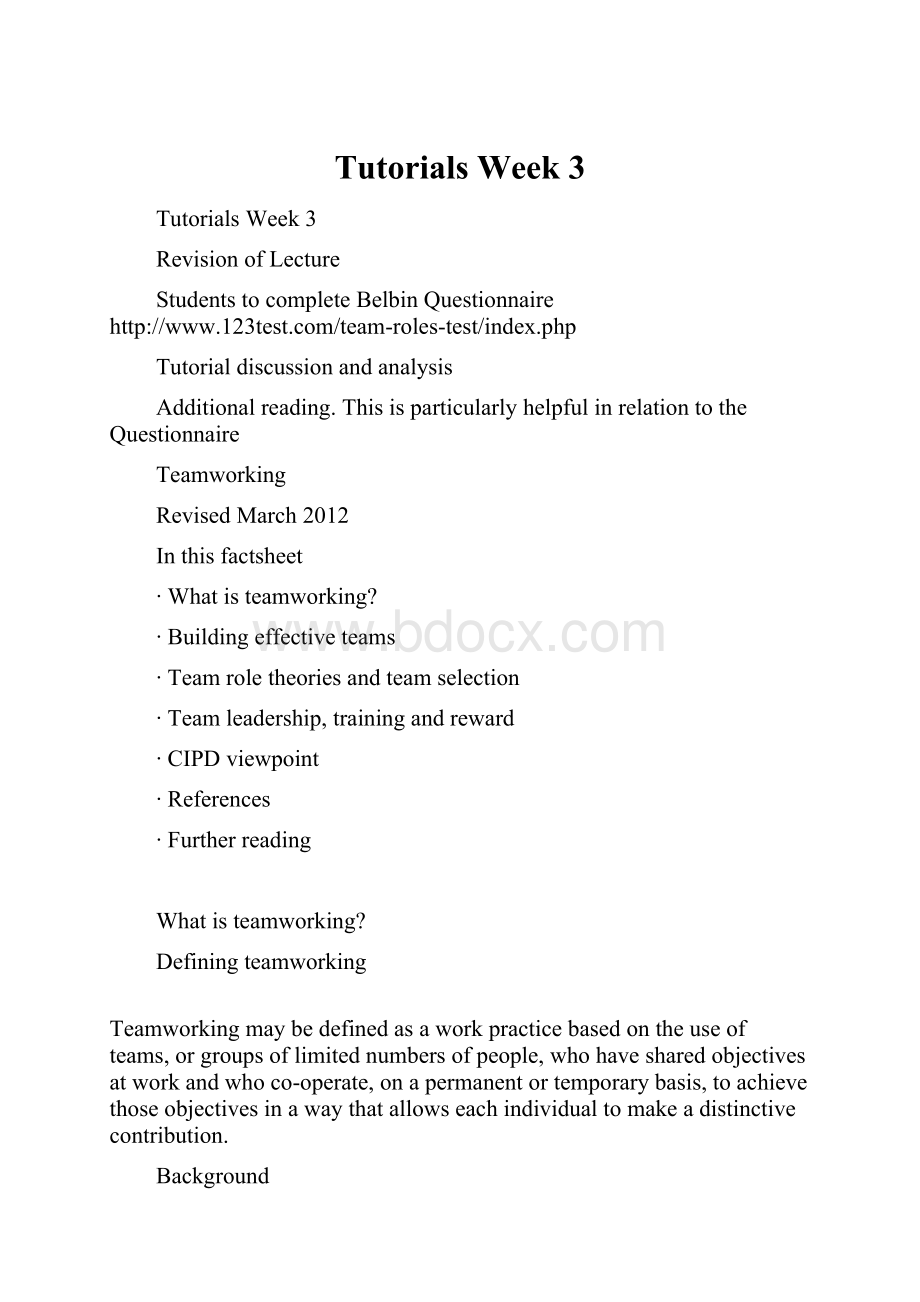Tutorials Week 3.docx
《Tutorials Week 3.docx》由会员分享,可在线阅读,更多相关《Tutorials Week 3.docx(19页珍藏版)》请在冰豆网上搜索。

TutorialsWeek3
TutorialsWeek3
RevisionofLecture
StudentstocompleteBelbinQuestionnaire
Tutorialdiscussionandanalysis
Additionalreading.ThisisparticularlyhelpfulinrelationtotheQuestionnaire
Teamworking
RevisedMarch2012
Inthisfactsheet
∙Whatisteamworking?
∙Buildingeffectiveteams
∙Teamroletheoriesandteamselection
∙Teamleadership,trainingandreward
∙CIPDviewpoint
∙References
∙Furtherreading
Whatisteamworking?
Definingteamworking
Teamworkingmaybedefinedasaworkpracticebasedontheuseofteams,orgroupsoflimitednumbersofpeople,whohavesharedobjectivesatworkandwhoco-operate,onapermanentortemporarybasis,toachievethoseobjectivesinawaythatallowseachindividualtomakeadistinctivecontribution.
Background
Inrecentdecades,teamworkinghasgrowninimportance.Previously,rolesatworkwereoftenwell-defined;inthetraditionalofficeorfactory,forexample,therewasusuallyastrictdivisionofresponsibilitiesandmostjobtitlesconveyedexactlywhichdutiespeoplewouldbeexpectedtoundertake.Butwithadvancesintechnologyandeducation,employersbegantoplaceagrowingemphasisonversatility,leadingtoanincreasinginterestinteamworkingatalllevels.Thegradualreplacementoftraditionalhierarchicalformswithflatterorganisationalstructures,inwhichemployeesareexpectedtofillavarietyofroles,hassimilarlyplayedapartintheriseoftheteam.
Morerecently,too,afocuson‘high-performance’or‘high-commitment’workpracticeshasplayedapartinfosteringtheuseofteamworking.The2004WorkplaceEmploymentRelationsSurvey(WERS)1foundteamworkingtobethemostcommonlyusedworkpracticeamongagroupofidentified‘high-performance’practices,withalmostthree-quartersofworkplacesdeployingatleastsomecoreemployeesinformally-designatedteams.
Typesofteam
Therearemanytypesofteams.Whatfollows2isnotacomprehensivelist,andthereareotherdefinitionsandclassifications,whilesometeamsmayfitintomorethanonecategory.
∙Productionandserviceteams–examplesareinproduction,construction,salesandhealthcare.Theyhavearelativelylonglife-span,providinganongoingproductorservicetocustomersorusersoftheorganisation.
∙Projectanddevelopmentteams–includingresearchandproductdevelopmentteams.Dedicatedtoaparticularobjective,theyhavelimitedlife-spansandaclearsetofshort-termobjectives.Theyareoftencross-functional,withmembersselectedforthecontributiontheirexpertisecanmake.
∙Adviceandinvolvementteams–withtheaimofimproving,forexample,workingconditionsorquality.Memberswillnotdevoteagreatdealoftimetothemand,oncetheyhaveachievedtheirobjectives,theyshouldbedisbanded.
∙Crews–suchasairlinecrews,whichmaybeformedfrommemberswhohaverarelyworkedtogetherbutthroughpriortrainingclearlyunderstandtheirrespectiveroles.
∙Actionandnegotiationteams–suchassurgicalandlegalteams,theseconsistofpeoplewhotendtoworktogetherregularly.Theyhavewell-developedprocessesandclearobjectives.
∙Virtualteams–whosemembersworkinseparatebuildingsandmayevenbeindifferentcountries.Theymayneedtocommunicatebytelephone,emailandtele-orvideo-conferencingratherthanface-to-face.Managingsuchteamscanbeparticularlydifficult,notleastbecauseremoteworkingcanexacerbatemisunderstandings.Wheresomemembersoftheremoteteamsarelocatedoverseas(forexample,withtheoffshoringofcertain‘back-office’roles),additionalchallengesmayarisewithissuessuchastimedifferenceswhenplanningcommunications.
∙Self-managedteams–wheremuchdecision-makingisdevolvedfromlinemanagerstoteammembers.Suchteamsmayalsobeknownassemi-autonomousorfullyautonomousteams,accordingtothedegreeofself-management.
Ingeneral,teamswillconsistofpeopleemployedbythesameorganisation,althoughsometimestheremaybeteamsfromdifferentemployers:
examplesaredesignprojectteamsinconstruction,whichbringtogetherarchitectsandengineersfromdifferentfirms,orteamsthatincludecustomersorsuppliers.
Teamscanincludeseniorandjunioremployees(forthelatter,teammembershipmayalsobeadevelopmentopportunity)andsomeonerelativelyjuniormaybeateamleader.
Mostcommentatorssuggestthatbetweenfiveandeightpeopleistheidealsizeforteams.Teamsneedtobelargeenoughtoincorporatetheappropriaterangeofexpertiseandrepresentationofinterests,butnotsolargethatteam-members’participation,andhencetheirinterest,islimited.
Benefitsofteamworking
Organisationsuseteamworkingformanyreasons,includingthedesiretoachievethefollowingobjectives:
∙improveproductivity
∙enhancequalityofproductsorservices
∙improvecustomerfocus
∙speedthespreadofideas
∙respondtoopportunitiesandthreatsandtofast-changingenvironments
∙increaseemployeemotivation
∙introducemulti-skillingandemployeeflexibility.
Therecanbebenefitsforemployeestoo.Themostcommonly-quotedpositiveoutcomesaregreaterjobsatisfactionandmotivationtogetherwithimprovedlearning.
Buildingeffectiveteams
Stagesofteamdevelopment
Woodcock’sseminaltheoryaboutteamfunctioningproposesthat,whenagroupofpeoplecometogethertoachieveanobjective,theygothroughaseriesofstagesleadingtoafinal'mature'stagethatequatestoaneffectiveteam3.
Themainstagesare:
∙Forming–orundeveloped,whenpeopleareworkingasindividualsratherthanateam.
∙Storming–theteambecomesmoreaggressive,bothinternallyandinrelationtooutsidegroups,rulesandrequirements.
∙Norming–orconsolidating,inwhichtheteamisbeginningtoachieveitspotential,effectivelyapplyingtheresourcesithastothetasksithas,usingaprocessithasdevelopeditself.
∙Performing –whentheteamischaracterisedbyopennessandflexibility.Itchallengesitselfconstantlybutwithoutemotionallychargedconflict,andplacesahighpriorityonthedevelopmentofotherteammembers.
∙Mourning–whentheteamdisbands.
Whilethisisausefultheoreticalmodel,itshouldnotbeseenasunvarying.Forexample,ateaminwhichthemembersknoweachotherwellmayperformeffectivelyalmostfromthestart.
Characteristicsofeffectiveteams
Aneffectiveteamhasthefollowingcharacteristics:
∙acommonsenseofpurpose
∙aclearunderstandingoftheteam’sobjectives
∙resourcestoachievethoseobjectives
∙mutualrespectamongteammembers,bothasindividualsandforthecontributioneachmakestotheteam’sperformance
∙valuingmembers’strengthsandrespectingtheirweaknesses
∙mutualtrust
∙willingnesstoshareknowledgeandexpertise
∙willingnesstospeakopenly
∙arangeofskillsamongteammemberstodealeffectivelywithallitstasks
∙arangeofpersonalstylesforthevariousrolesneededtocarryouttheteam’stasks.
Teamroletheoriesandteamselection
Twocentralrequirementsforteammembershipmaybeidentified:
∙theteamshouldincludearangeofthenecessarytechnicalandspecialistskills
∙thereshouldbeavarietyofpersonalstylesamongmemberstofillthedifferentrolesthatareinvolvedinsuccessfulteamwork.
Teamroles
Thewell-knownexpertinthefieldofteamworking,DrMeredithBelbin,undertookpioneeringworkonteamrolesortypesduringthe1970sandhascontinuedtoprogresshisworkinthisareainsuccessivedecades4.Belbinhasdevelopedandslightlyamendedhisdescriptionofteamrolesovertheyearsandinhislaterworklistsnineroles5:
∙Plant–creative,imaginative,unorthodox.Solvesdifficultproblems.
∙Resourceinvestigator–extrovert,enthusiastic,exploratory.Exploresopportunities.Developscontacts.
∙Co-ordinator–mature,confident,agoodchairperson.Clarifiesgoals,promotesdecisionmaking.
∙Shaper–dynamic,challenging.Hasdriveandcouragetoovercomeobstacles.
∙Monitorevaluator–sober,strategic,discerning.Seesalloptions.
∙Teamworker–co-operative,mild,perceptive,diplomatic.Listens,builds,avertsfriction.
∙Implementer–disciplined,reliable,conservative.Turnsideasintopracticalaction.
∙Completer–painstaking,conscientious,anxious.Searchesouterrorsandomissions,deliversontime.
∙Specialist–single-minded,self-starting,dedicated.Providesknowledgeandskillthatmaybeinshortsupply.
Belbin’sworkhasbeencriticisedonthegroundsthatindividualsrarelyfitneatlyintothesecategories–mostfitintomorethanonecategorywhile,arguably,thebestteamworkerswilladapttheirbehaviourtofilldifferentrolesascircumstancesrequire.However,anawarenessthatanindividualteammembertendstofitacertainprofilemayhavevalueinunderstandingthestrengthsandweaknessesofthatindividualandotherteammembers.
SubsequentinvestigationsbytheacademicsMargerisonandMcCannconfirmtheneedidentifiedbyBelbinforcomplementaryskillswithinateam,leadingtotheirdevelopmentoftheconceptofa‘teammanagementwheel’6.TheMargerison-McCannworkstressestheneedforindividualdevelopmentasanessentialfirststeptoteamdevelopment,withbothoftheseaspectsplacedfirmlyinthecontextofclearbusinessobjectives,andhighlightsthekeyrolefora‘linker’atthecentreoftheteammanagementwheelmodel.
Selectingteammembers
Therearemanyotherpsychologicaltestsandcriteriathatresultindifferentteamtypeclassifications.Organisationsmaywishtolookatasampleofteststoconsiderwhichmightbemostappropriateiftheyintendtousethemtoselectteammembersand,especially,te